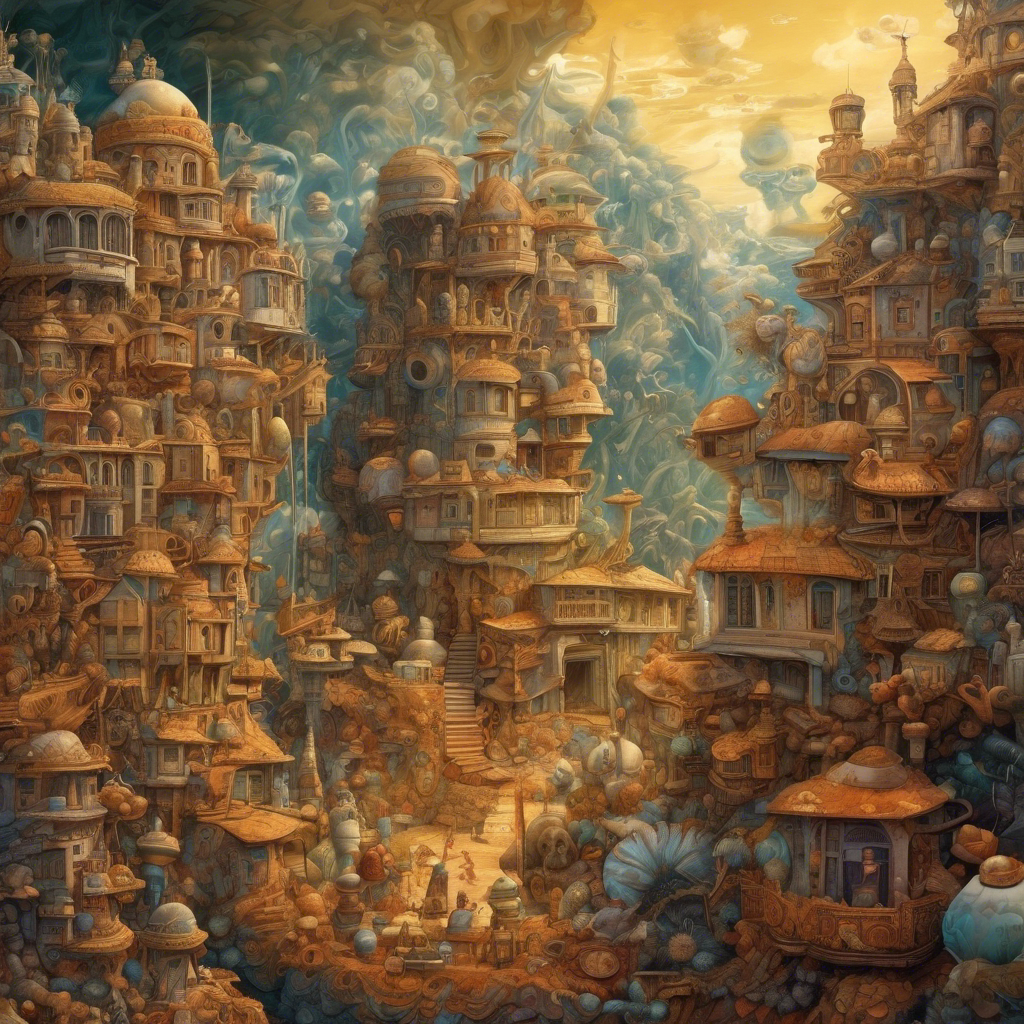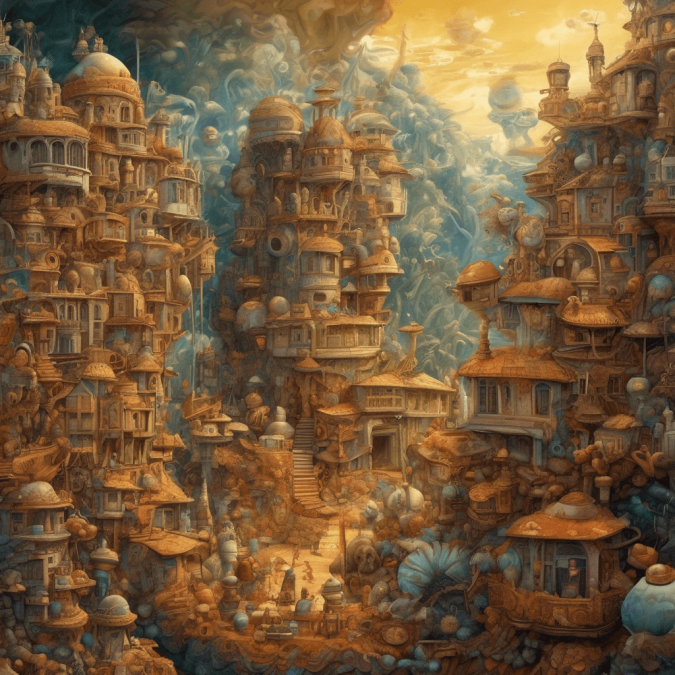
Atra-Hasis is an ancient Mesopotamian myth that tells the story of a flood and the hero Atra-Hasis who survives it. The myth is similar to the biblical story of Noah’s Ark. It describes how the gods decided to destroy humanity due to their noise and overpopulation. The god Enki, however, warns Atra-Hasis and instructs him to build a large boat to save himself, his family, and various animals. After the flood subsides, Atra-Hasis offers sacrifices to the gods who then regret their decision and grant him immortality. The myth explores themes of humanity’s relationship with the gods, the consequences of overpopulation, and the hero’s journey. Atra-Hasis is considered an important myth in Mesopotamian literature and provides insights into ancient beliefs and values.
The Atra-Hasis myth is an ancient Mesopotamian tale that dates back to around 1900 BCE and is one of the earliest known flood myths in human history. The story unfolds in the land of Sumer, where the gods have created humanity to serve them and tend to the earth. However, as time passes, the gods become displeased with the noise and overpopulation of humanity, feeling that their work is too burdensome.
The gods convene a council to discuss the issue, and it is decided that a great flood will be sent to wipe out mankind and start anew. The god Enlil, the chief deity, is particularly adamant about this decision and instructs the other gods to keep the impending flood a secret from humanity.
However, the god Enki, known for his wisdom and compassion towards humanity, takes pity on them and decides to warn a mortal man named Atra-Hasis about the impending disaster. Enki speaks to Atra-Hasis in a dream, telling him to build a large boat and stock it with provisions to save himself, his family, and representatives of all living creatures.
Atra-Hasis heeds Enki’s warning and diligently follows his instructions, constructing a massive boat that can withstand the floodwaters. As the flood descends upon the earth, Atra-Hasis, his family, and the animals take refuge in the boat, safe from the devastation that engulfs the land.
For seven days and seven nights, the floodwaters rage, covering the earth and wiping out all living beings. But Atra-Hasis and those with him remain safe inside the boat, protected by the divine intervention of Enki. Eventually, the floodwaters recede, and the boat comes to rest on a mountaintop.
Upon exiting the boat, Atra-Hasis is filled with gratitude and relief, knowing that he and his loved ones have been spared from the wrath of the gods. He offers sacrifices to the gods, expressing his reverence and thankfulness for their mercy.
The gods, moved by Atra-Hasis’s piety and devotion, regret their decision to destroy humanity and grant him immortality as a reward for his faithfulness. Atra-Hasis becomes a symbol of resilience and faith, a mortal who has defied the odds and earned the favor of the divine through his unwavering belief.
The story of Atra-Hasis is a testament to the enduring power of myth to convey universal truths about the human experience. It explores themes of redemption, divine intervention, and the cyclical nature of life and death. Through the character of Atra-Hasis, we see the potential for humanity to overcome adversity and find grace in the face of overwhelming challenges.
As we reflect on the story of Atra-Hasis, we are reminded of the importance of humility, faith, and gratitude in navigating the complexities of existence. The myth serves as a timeless parable, offering insights into the nature of divinity, the resilience of the human spirit, and the eternal cycle of creation and destruction that shapes our world.
The Atra-Hasis myth features several key characters who play pivotal roles in the narrative. Here are some of the main characters in the story:
1. Atra-Hasis: The hero of the story, Atra-Hasis is a mortal man chosen by the god Enki to survive the impending flood. He is depicted as a wise and pious individual who follows divine instructions to build a boat and save himself, his family, and various animals from the catastrophe.
2. Enki: One of the chief gods in Mesopotamian mythology, Enki is known for his wisdom, compassion, and affinity for humanity. In the Atra-Hasis myth, Enki warns Atra-Hasis about the upcoming flood and provides him with the knowledge and guidance needed to survive. His intervention saves Atra-Hasis and earns him the favor of the gods.
3. Enlil: Another prominent deity in Mesopotamian mythology, Enlil is the chief god who initially decides to send the flood to destroy humanity due to their noise and overpopulation. Enlil represents the stern and authoritative aspect of the divine and serves as a catalyst for the events of the story.
4. Other Gods: The pantheon of Mesopotamian gods, including figures like Anu, Ninhursag, and Inanna, are also present in the Atra-Hasis myth. These gods participate in the council that decides to send the flood and later express regret for their actions after Atra-Hasis survives.
5. Atra-Hasis’s Family: While not individually named in the myth, Atra-Hasis’s family members, including his spouse and children, accompany him on the boat and are saved from the flood along with him. Their presence underscores the theme of survival and the importance of familial bonds in the face of adversity.
6. Animals: Atra-Hasis is instructed to bring representatives of various animal species onto the boat to ensure their survival during the flood. The animals serve as symbols of biodiversity and the interconnectedness of all living creatures in the natural world.
These characters interact and contribute to the unfolding of the Atra-Hasis myth, embodying different aspects of divinity, humanity, and the cosmic order. Their actions and relationships shape the narrative and convey deeper meanings about the human experience and our place in the universe.
The Atra-Hasis myth, an ancient Mesopotamian tale, has captivated scholars and enthusiasts alike for centuries with its compelling narrative and profound themes. This myth, reminiscent of the biblical story of Noah’s Ark, offers a unique perspective on the relationship between humanity and the divine, the consequences of human actions, and the hero’s journey. In this article, we will delve deep into the rich tapestry of the Atra-Hasis myth, unraveling its hidden meanings, exploring its historical and cultural context, and examining its enduring relevance in the modern world.
Historical and Cultural Context
To fully appreciate the Atra-Hasis myth, we must first understand the historical and cultural context in which it emerged. Mesopotamia, the cradle of civilization, was home to a diverse pantheon of gods and goddesses who played a central role in the lives of its inhabitants. Myths served as a way to explain the mysteries of the world, uphold social order, and impart moral lessons to the people. The Atra-Hasis myth, with its focus on the gods’ decision to flood the earth and the hero’s quest for survival, reflects the ancient Mesopotamians’ beliefs about the capricious nature of the divine and the fragility of human existence.
Analysis of the Myth
The Atra-Hasis myth begins with the gods’ discontent over humanity’s noise and overpopulation, leading them to decide to wipe out mankind with a great flood. However, the god Enki intervenes, warning the hero Atra-Hasis of the impending disaster and instructing him to build a boat to save himself, his family, and a selection of animals. As the floodwaters subside, Atra-Hasis offers sacrifices to the gods, who, moved by his piety, grant him immortality. This narrative raises profound questions about the nature of divinity, the consequences of human actions, and the possibility of redemption in the face of divine wrath.
Themes and Symbolism
The Atra-Hasis myth is replete with rich themes and symbolism that invite deeper reflection. The flood itself symbolizes the cyclical nature of destruction and renewal, reflecting the Mesopotamian belief in the cosmic order. Atra-Hasis, as the hero who survives the flood and receives immortality, embodies the archetype of the survivor who overcomes adversity and gains divine favor. The sacrifices offered by Atra-Hasis after the flood underscore the importance of piety and humility in appeasing the gods and securing their blessings. These themes resonate across cultures and time periods, speaking to universal truths about the human condition and our relationship with the transcendent.
Comparative Analysis
The Atra-Hasis myth shares striking similarities with other flood myths from around the world, such as the biblical story of Noah’s Ark, the Epic of Gilgamesh, and the Indian tale of Manu. These parallels highlight the common human experience of grappling with the forces of nature, the inevitability of death, and the hope for rebirth and renewal. By examining these myths in concert, we gain a deeper understanding of the shared cultural heritage of humanity and the enduring power of myth to illuminate the mysteries of existence.
Relevance Today
While the Atra-Hasis myth originated in ancient Mesopotamia, its themes and messages continue to resonate in the modern world. In an age of environmental crisis, overpopulation, and social upheaval, the story of a flood that threatens to wipe out humanity serves as a cautionary tale about the consequences of human hubris and the need for humility and reverence in the face of natural forces. The figure of Atra-Hasis, the humble hero who survives the flood through his piety and devotion, offers a model of resilience and faith that can inspire us in our own struggles and challenges.
Conclusion
The Atra-Hasis myth stands as a timeless masterpiece of ancient storytelling, weaving together themes of divinity, humanity, and the eternal cycle of destruction and renewal. By exploring the historical context, analyzing the narrative, and uncovering its deeper meanings, we gain a deeper appreciation for this myth and its enduring relevance in the modern world. As we reflect on the lessons of Atra-Hasis, we are reminded of the power of myth to illuminate the human experience and guide us on our own journey of discovery and transformation.
There are several books and scholarly works that delve into the Atra-Hasis myth and its significance in Mesopotamian literature and mythology. Here are some recommended books that explore the myth and related topics:
1. “The Harps that Once…: Sumerian Poetry in Translation” by Thorkild Jacobsen – This book includes translations of Sumerian literary texts, including myths like the Atra-Hasis epic, providing insights into ancient Mesopotamian culture and beliefs.
2. “From the Ashes of Angels: The Forbidden Legacy of a Fallen Race” by Andrew Collins – While not solely focused on the Atra-Hasis myth, this book delves into ancient Mesopotamian mythology and its connections to other cultures and mythologies.
3. “Myths from Mesopotamia: Creation, The Flood, Gilgamesh, and Others” translated by Stephanie Dalley – This collection of translated texts includes the Atra-Hasis myth along with other Mesopotamian myths, offering a comprehensive look at the rich mythological tradition of the region.
4. “The Buried Book: The Loss and Rediscovery of the Great Epic of Gilgamesh” by David Damrosch – While centered on the Epic of Gilgamesh, this book provides background on Mesopotamian myths and the context in which they were preserved and transmitted.
5. “The Babylonian Genesis: The Story of the Creation” by Alexander Heidel – This book explores various creation myths from ancient Mesopotamia, including the Atra-Hasis flood story, shedding light on the cosmological beliefs of the Babylonians.
6. “The Sumerians: Their History, Culture, and Character” by Samuel Noah Kramer – This comprehensive study of Sumerian civilization includes discussions of Sumerian myths and literature, providing context for understanding the Atra-Hasis myth within its cultural milieu.
These books offer valuable insights into the Atra-Hasis myth, Mesopotamian mythology, and the broader cultural and historical context in which these ancient texts were composed and transmitted. They provide readers with a deeper understanding of the rich literary and religious traditions of ancient Mesopotamia and the enduring significance of these myths in shaping human thought and belief systems.
